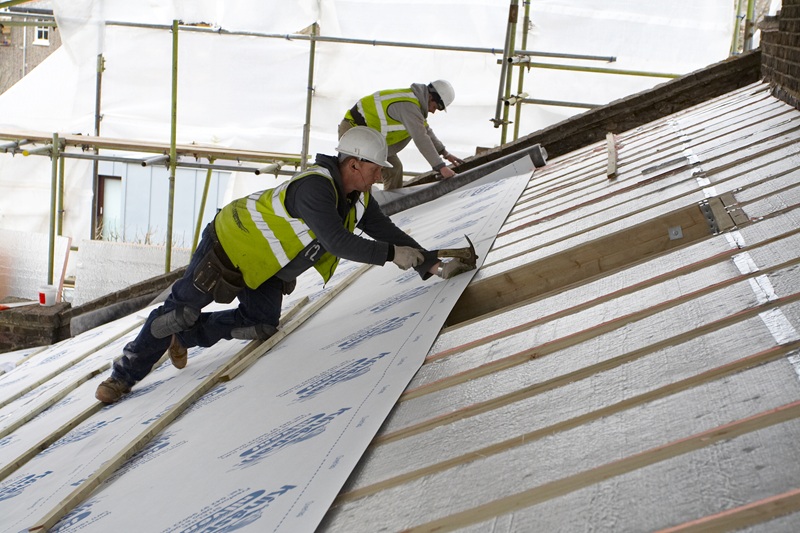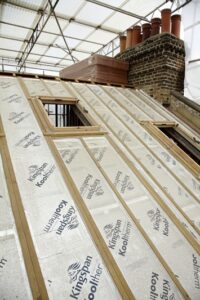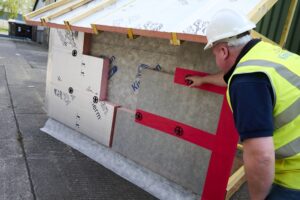
Jonathan Ducker, Head of Regulatory Affairs at Kingspan Insulation GB, explores the future of roofing insulation
All being well, the Future Homes Standard is expected to be published before the end of the year. This update to the Building Regulations in England will set new requirements for new build homes, including switching to low carbon heating (typically heat pumps) and setting new targets for energy demand and carbon emissions designed to ensure they’re “net-zero ready”.
When it comes to energy performance, the best first step is to keep heating demand to a minimum. This means ensuring the roofs, walls and floors are well insulated. For example, if you’re planning on including a room-in-the-roof on your builds, it’s a good idea to fit the insulation between and above the rafters. This can help maximise the floor-to-ceiling height without compromising on U-values and also makes detailing much simpler.
Planning for the Future
In the consultation for the Future Homes Standard, two different options were proposed for the Notional Dwelling specification. This is applied to a theoretical building of the same dimensions as the proposed home within the energy modelling software to generate the performance targets for the building. As with the existing standards, you are free to vary from this specification providing you meet the performance targets, limiting values (such as worst-case U-values) and any other mandatory requirements (such as using low carbon

Aside from the switch to low carbon heating, one of the proposed options is largely unchanged from the existing requirements in Approved Document L 2021 (ADL 2021). The other option limits air loss to 4 m3/m2.h @ 50Pa with ventilation provided via a mechanical ventilation heat recovery system, and includes both roof PV and wastewater heat recovery.
Surprisingly, neither of the specifications require the building fabric to be upgraded beyond the current values. This is despite the U-values in the English Notional Dwelling lagging significantly behind the current equivalents in Scotland and Wales in most areas.
With the switch to heat pumps, which perform most efficiently (and affordably!) at lower flow temperatures than conventional boilers, ensuring homes retain heat well will be more important than ever. For this reason, it’s worth looking at matching the U-values used in the current Notional Building in Scotland – 0.09 W/m2K.
Wrapping up
When targeting very low U-values, the thermal conductivity (lambda value) of the insulation is especially important. The lower this value is, the more effective the insulation will be at reducing heat loss. This can allow the U-value to be met with a slimmer construction than might be possible with materials with a higher (worse) thermal conductivity. Rigid phenolic roof insulation boards are a good choice when targeting U-values around 0.09 W/m2K as they tend to have the lowest thermal conductivity of any commonly used insulation board (as low as 0.019 W/mK). This means that they won’t need to be as thick as most other materials to meet that U-value.
Along with the choice of insulation, it is also worth giving some thought to the build-up you’re using, especially for room-in-the-roof constructions. In the past, the typical approach has been to fit insulation between the rafters with a further layer of insulated plasterboard below. However, even when fully filling between 150 mm rafters with phenolic insulation this can still require a substantial thickness of insulated plasterboard beneath just to reach a U-value of 0.11 W/m2K (as in the existing Notional Dwelling in England). This often means ridge heights have to be raised to ensure there is sufficient headroom in the space below.

It’s usually more straightforward to fit phenolic insulation between the rafters, with a further layer above. In addition to making it easier to reach low U-values, fitting a continuous layer of insulation above the rafters can also help to simplify detailing and limit repeating thermal bridges through the rafters. This can support compliance with carbon and primary energy targets within the expected FHS, and should help to ensure that the finished roofs retain heat effectively.
When adopting this approach, you’ll usually need to install a breathable membrane above the insulation, followed by the cross battens for the roof tiles. A Vapour Control Layer (VCL) applied to the internal face of the insulation behind the plasterboard lining can help provide both vapour control and good levels of airtightness.
Putting fabric first
Whatever is included in the Future Homes Standard when it is finally published, getting the insulation right will be vital to lower carbon emissions whilst also keeping heating costs affordable for owners. It’s worth starting to plan now for ways you can lower U-values without having to compromise on internal space. A between and over approach to pitched roofs with low thermal conductivity insulation is one way to deliver this.
For further information on Kingspan Insulation GB click here







